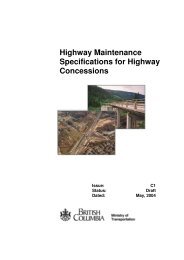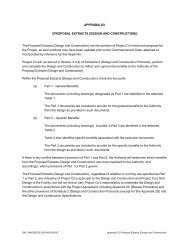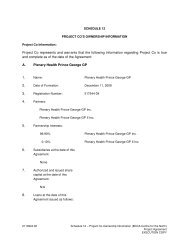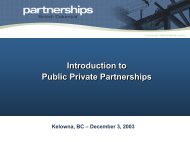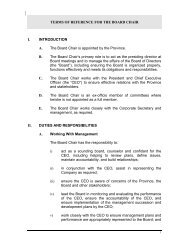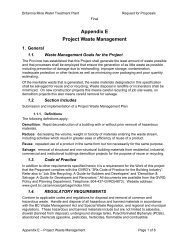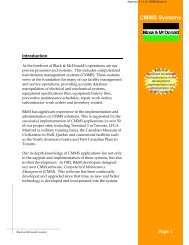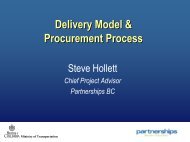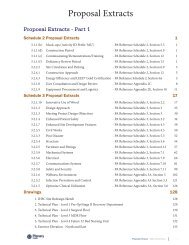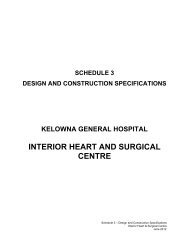Resort Municipality of Whistler Request for Proposal for Project ...
Resort Municipality of Whistler Request for Proposal for Project ...
Resort Municipality of Whistler Request for Proposal for Project ...
Create successful ePaper yourself
Turn your PDF publications into a flip-book with our unique Google optimized e-Paper software.
<strong>Resort</strong> <strong>Municipality</strong> <strong>of</strong> <strong>Whistler</strong> and Partnerships BC<br />
RFP <strong>Project</strong> Manager<br />
April 27, 2005<br />
While there are many unknowns about <strong>Whistler</strong>’s future, we do know the four basic TNS<br />
principles that we need to respect <strong>for</strong> this future to be sustainable. These were developed by<br />
identifying the ways that humans destroy natural and social systems. These mechanisms were<br />
then changed to principles that specify how to avoid this destruction. The four TNS principles,<br />
based on scientific consensus, are concrete and non-overlapping, define our sustainability<br />
goals, and guide our thinking and planning.<br />
As with any goal, the best way to achieve it is to envision ultimate objectives and then take stepby-step<br />
actions to get there. This process is called backcasting.<br />
<strong>Whistler</strong> will take steps to move toward four ultimate sustainability objectives, based on the TNS<br />
sustainability principles. These are to eliminate <strong>Whistler</strong>’s contribution to:<br />
1. Progressive build-up in concentrations <strong>of</strong> waste derived from the earth's crust. For<br />
example, the resort community is interested in transitioning to renewable energy sources<br />
such as ground source heat pumps.<br />
2. Progressive build-up in concentrations <strong>of</strong> materials produced by society. For example,<br />
the municipality is interested in securing a long-term beneficial use <strong>of</strong> biosolids.<br />
3. Ongoing physical degradation <strong>of</strong> nature. For instance, the resort community uses ecocertified<br />
building materials (e.g., sustainably harvested wood).<br />
4. Undermining <strong>of</strong> other people’s ability to meet their needs. For example, supporting<br />
Water For People, an international non-pr<strong>of</strong>it organization that focuses on long-term,<br />
sustainable water supply and sanitation programs in developing countries.<br />
The non-prescriptive nature <strong>of</strong> <strong>Whistler</strong>’s sustainability objectives should help to unleash<br />
creativity that allows us to identify opportunities <strong>for</strong> moving toward sustainability. The resort<br />
community has used these objectives to develop <strong>Whistler</strong> 2020, and encourages their use in all<br />
decision-making.<br />
3.0 <strong>Project</strong> Background<br />
3.1 <strong>Project</strong> Goals and Objectives<br />
The goals and objectives <strong>of</strong> this project are summarized below:<br />
1) The project must be consistent with <strong>Whistler</strong> 2020 – Moving Toward a Sustainable<br />
Future, which is the municipality’s long-term, overarching, community-wide plan that is<br />
guided by our values and sustainability principles, and sets out a shared vision <strong>of</strong> what<br />
the resort community will look like in a successful and sustainable future.<br />
2) The project must be consistent with The Natural Step framework, which the RMOW<br />
adopted in 2000 and now uses to understand and plan <strong>for</strong> a sustainable society,<br />
including ecological and economic sustainability.<br />
3) Meet the requirements <strong>of</strong> the <strong>Whistler</strong> Liquid Wastewater Management Plan.<br />
4) Improve the quality <strong>of</strong> the effluent discharge.<br />
5) Upgrade the wastewater treatment plant in the most cost-effective and efficient way.<br />
6) Reduce the operating costs <strong>of</strong> the wastewater treatment plant.<br />
7) Eliminate <strong>of</strong>fensive odour at property line at all times following the upgrade to the plant.<br />
8) Reduce the risk to the RMOW with respect to cost, schedule and technical per<strong>for</strong>mance.<br />
FINAL Page 5



